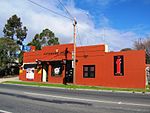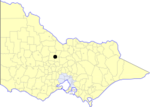Bendigo Stadium
Bendigo Stadium (also known as Red Energy Arena under naming rights) is an Australian sports and entertainment centre in Bendigo, Victoria. The stadium is home to the Bendigo Braves (NBL1) and Bendigo Spirit (WNBL). It hosted basketball matches during the 2006 Commonwealth Games and will host netball during the 2026 Commonwealth Games. The stadium's facilities include ten indoor sports courts, major exhibition and function areas, a licensed clubroom and associated administration facilities. The stadium has the flexibility to be used for major sporting, cultural and entertainment events and has held such events as The Young Divas, Vanessa Amorosi, international basketball, netball, snooker and volleyball. The largest recorded attendance at the venue was on 3 March 2013 when Bendigo Spirit defeated the Townsville Fire 71–57 in the 2012-13 WNBL Grand Final. In May 2018, the venue was re-opened after a $23 million redevelopment was completed which upgraded the facilities and increased the venue's capacity.The stadium hosted its first Suncorp Super Netball match on 25 May 2019, when Collingwood Magpies played West Coast Fever in a 2019 Suncorp Super Netball Round 5 match. It was part of a double header that also featured Tasmanian Magpies play Western Sting in an Australian Netball League fixture.The facility co-hosted the 2003 FIBA Oceania Championship where the Australian national basketball team won the gold medal. Bendigo also hosted Group 3 of The International Volleyball Women's Grand Prix in June 2016 over 3 days of which Australia competed against Cuba Columbia and Croatia The Arena has also hosted Australian National Basketball League Games for Melbourne United during the 2020–21 NBL season, Including Throwdown V against the South East Melbourne Phoenix. It also hosted a Round 11 Match where the New Zealand Breakers played Melbourne United in a Breakers Home Game. On 21 March 2022, it was announced that Bendigo Stadium would also host 2 further New Zealand Breakers Home Games during the 2021-22 NBL season, due to COVID-19 Protocols restricting the Breakers from returning to New Zealand. They played the South East Melbourne Phoenix on 10 April 2022 and the Sydney Kings on 12 April 2022, with the Breakers losing both Games.
Excerpt from the Wikipedia article Bendigo Stadium (License: CC BY-SA 3.0, Authors).Bendigo Stadium
Inglis Street, Bendigo West Bendigo (West Bendigo)
Geographical coordinates (GPS) Address Website Nearby Places Show on map
Geographical coordinates (GPS)
| Latitude | Longitude |
|---|---|
| N -36.758333333333 ° | E 144.24916666667 ° |
Address
Red Energy Arena
Inglis Street 91
3550 Bendigo, West Bendigo (West Bendigo)
Victoria, Australia
Open on Google Maps






